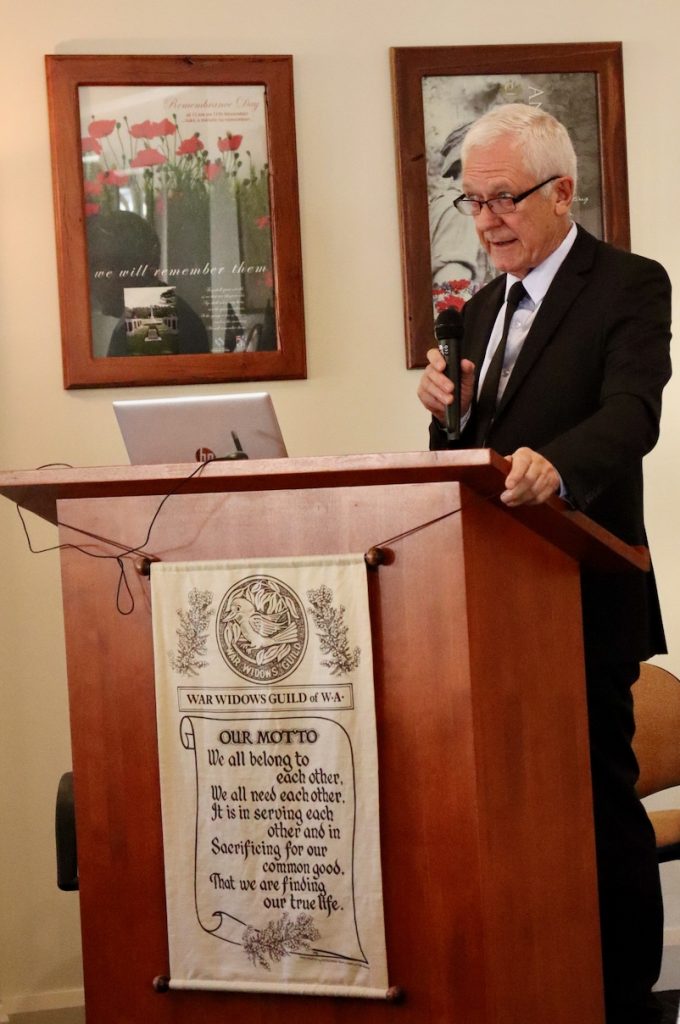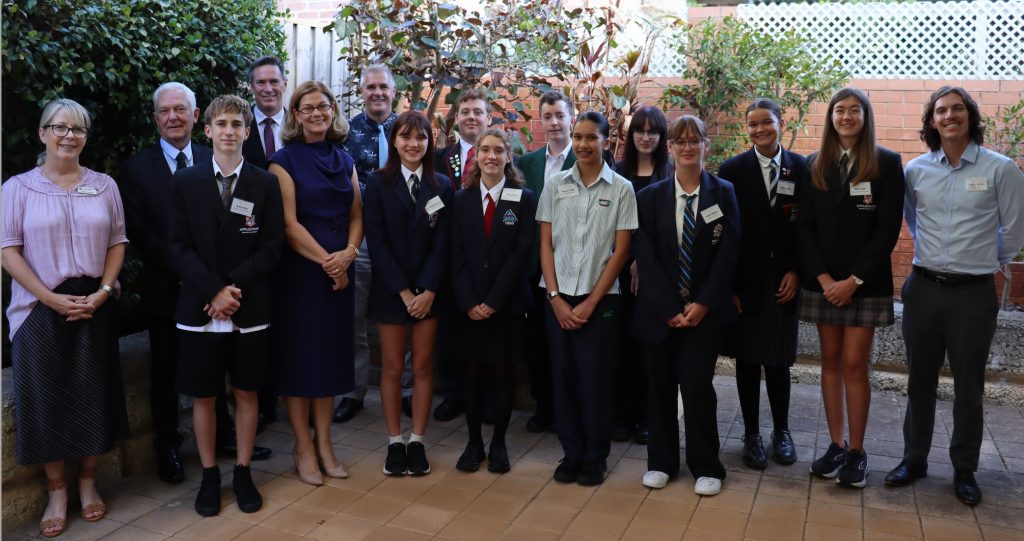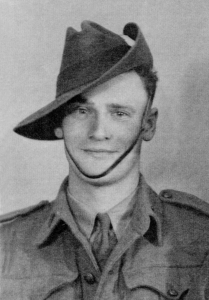2024 PREMIER’S ANZAC STUDENT TOUR – JIM RIDGWELL
Jim Ridgwell, younger son of Dick & Alma Ridgwell is the Treasurer and Committee Member of 2/4th MGB ex-Members Assoc. During the past years Jim has given time to the Premier’s School Student Anzac Tour Group.

‘The 2024 Premier’s Anzac Student Tour will travel to Singapore in April to commemorate the 82nd anniversary of the fall of Singapore.

The successful student ambassadors for the 2024 Premier’s Anzac Student Tour are:
- Caitlyn Willis, Guildford Grammar School
- Avery Flint, Applecross Senior High School
- Milla Lobik, Applecross Senior High School
- Mazlyn Membry, Manjimup Senior High School
- Tahlia Watson, Geraldton Senior High School
- Aja Kondo-Morcom, Mount Lawley Senior High School
- Keona Latiff, Canning Vale College
- Freya Hicks, Christmas Island District High School
- Tim Kania, Aquinas College
- William Temby, Margaret River Senior High School
The Premier’s Anzac Student Tour is an annual competition open to all Western Australian students in Years 8 to 11.’
The following is Jim’s address to the Student Body for 2024:
My father was Dick Ridgwell, WX14197

He was born in 1918
To put that in perspective;
Aeroplane flight had only recently become a reality
WWI ended in 1918
The world’s first three-color traffic lights are introduced in New York City.
Nelson Mandella was born in 1918.
Dad joined the army on 11th June 1941 and became a member of the 2/4th Machine Gun Battalion.
This unit was to comprise of 965 men who bar a couple were all from Western Australia. There were only 450 000 people in WA at the time, the 2/4th were a considerable proportion from this population. There is a very strong possibility that some of you had relatives in the unit.
The 2/4th landed at Singapore on Dad’s 24th birthday and they were all thrust into war and a future they never could foresee.
I was exposed to National Conscription into the Australian Army when I turned 20 in 1970. There are many accounts of 16-17-year old’s enlisting in WW1 and WW11. The youngest record I could find was a boy of 12 years old who fought in WW1 at the Somme in France. (take a moment to think how that would affect you, and your family if you were in their place.)
Australia and Britain capitulated about a week after Dad landed in Singapore and they were all taken Prisoners of War for the next 3 ½ years.
Today, I want to talk to you about some qualities which helped these men survive and in fact are uniquely Australian.
Those qualities are;
Resilience
Mate ship
Determination
Passive resistance
And I will give you examples by way of short stories and anecdotes of men displaying these qualities under extreme hardship and violence.
One might think all nations have these qualities, but there is much evidence where these qualities have been lacking in adverse situations and men have suffered as a result. Australians display these qualities regularly and naturally.
Some of the vernacular used in these stories is from the men themselves and may not be appropriate by today standards. So, I apologize for that in advance.
The first of these qualities would come under the heading of RESILIENCE, DETERMINATION and perhaps MATESHIP
DICK RIDGWELL’S ENCOUNTER WITH THE SIKH
Soon after the 2/4th were taken prisoner in Singapore the Japs didn’t know what to do with us so we were accommodated in private houses taken from their owners. Where a house would have accommodated a family of perhaps 4, there were about 50 of us in each of these houses. The houses were almost bare of furnishings and possessions, having been looted before we got there. The few items, such as fans etc., left we sold to locals to buy food. There were 4 houses, and about 100 yards from the houses was the jungle.
During the days we were split into working parties. My lot were forced to build a shrine for the Japs to their Emperor. At night we were pretty much left to our own devices.
One day 3 of us, I, Roy Nybo and Shorty Jefferies crept out and found a coconut plantation, which prior to the outbreak of war, was owned by a Chinese family. They were allowed to stay and work the plantation for the Japanese army. We planned to steal coconuts and take them back to our accommodation. Roy went up the coconut palm and threw down coconuts while Shorty and I collected them.
The Japs had assigned Sikh prisoners the responsibility of guarding various installations and armed them with golf clubs.
One of the Sikhs spotted us in the plantation and came over to stop us. We refused and an argument ensued. Eventually he attacked us with his golf stick. He struck Nybo over the head leaving the golf stick the shape of Nybo’s head and shoulders. The Sikh and I fought and during this he grabbed my dog tags and tore them off me. To try and get them back I made a grab for them but grabbed his comb and string he wore in his hair. Thinking I had been successful I headed for home. The other 2 had already headed off with the coconuts.
When I got back and realised what I had in my hand. I was worried sick the Sikh would turn my dog tags into the Japs. This could have resulted in a beating at the least or death at worst.
I went to Capt Smith-Ryan and told him of the events. I asked him if he could vouch that I was in the camp at that time but he said “Serves you right. You have been looking for trouble” and refused to help. Lt Don Lee followed me out and said he would cover for me.
I hadn’t had a shave or haircut since being taken prisoner weeks ago so I was looking pretty scruffy. I went to Len Armstrong, our barber, and got him to give me a half shave and haircut to hopefully change my appearance.
Surprisingly there were no repercussions from our little venture that day.
Months later I got a message that the Chinaman from the coconut plantation wanted to see me. I crept out and made my way to his house undetected. As it turned out, the Sikh had turned my dog tags into him and he just wanted to return them to me. I still have them to this day.
A lucky escape indeed!
THE next story demonstrates PASSIVE RESISTANCE.
A large contingent of 2/4th POWs were sent to construct a shrine for the Emperor of Japan. As this was being constructed, out of wood, Dad and others used to catch ants before they headed out in the morning and release them within the wooden structure in the hope the ants would destroy the shrine in time. Now we all know how futile that would have been but it’s a good example of “passive resistance”
The 3rd and last story I want to share with you is a good example of MATESHIP.
Some years ago, my wife and I, accompanied by my father, did a tour of the “Burma Railway.” There was approximately 40 people on that tour, and we were fortunate to have 5 ex POW’s accompany us. One of them of course was Dad. Each of these men told us stories and some funny anecdotes from that time.
One story I vividly remember was told on the side of the road at an old POW camp site. Bill Haskell, was an amazing orator, He told us the story of the old camp we were sitting in. He explained where the men slept, where the sick were attended to, location of the latrines and where the cholera camp was. Most camps had an isolated area for these men so cholera didn’t infect others.
Bill explained how all but the critically ill were sent out on work parties. Only the sickest remained, and it was from those sick men one was assigned as camp cook for the day.
He described how the work party, at the time, was working over 2 mountains away and walked there and back over an 12-15-hour days. Many of these “Fit” men had dysentery, malaria, tropical ulcers, and suffered from severe malnutrition.
The camp cook was aware these men had no water for the day and if they didn’t have access to water they would perish. So, this man, and remember he was one of the sickest in camp, carried 2 large glass demijohns of water over the 2 mountains twice, and sometimes 3 times a day just so his mates didn’t perish of dehydration.
So, let’s review those qualities I mentioned earlier.
Resilience
Mate ship
Determination
Passive resistance
Can I suggest all of you have demonstrated these qualities by struggling and studying to become part of this group of young Australians representing our country. This experience will stay with you all your lives now.
You are a credit to your schools and a credit to Australia.
Congratulations to you all!
Now, as I understand it one of the aims of this tour “is to ensure the ongoing legacy and recognition of Anzac Day as an important National Day of Commemoration”
In my view, the greatest legacy which has been left to us is the freedom and democracy our soldiers, men, and women, from all the conflicts we have been involved in, have left us. There is turmoil in other countries around the world we are involved in even now, but our Australia remains stoic. We must remember, freedom and democracy are not free and we must never take them for granted. That is what I consider Anzac day is about.
We will remember them!
Finally, Dad’s advice to longevity was to live healthily, don’t hold a grudge and love your family.
He passed away 7 weeks before his 100th birthday.
References:



